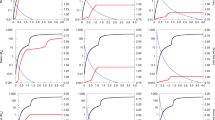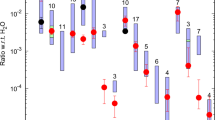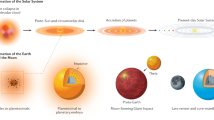Abstract
The mean density of the Pluto-Charon system is now accurately known at 1.99±0.09 g cm–3 (With formal errors five times smaller)1, through observations of total occultations and transits2. Even allowing Charon's density to vary between 1 and 3 g cm–3 constrains Pluto's density between 1.84 and 2.14 g cm–3. Pluto is thus very rock-rich, with a rock/(rock + H2O-ice) mass ratio of ˜0.68–0.80, much greater than those of the icy satellites Ganymede, Callisto or Titan. It is so rock-rich that spontaneous unmixing of rock and ice phases in its convecting interior is just possible, and any significant differentiation during accretion or during Charon's formation, which may have involved a large-body impact3–5, renders Pluto unstable to further melting and differentiation because the resulting multiple thermal boundary layers inhibit heat transport6. Continual loss of methane over the age of the Solar System7,8 requires a near-surface methane reservoir, and implies that non-trivial differentiation has occurred9. Pluto is probably a differentiated object whose icy mantle is entirely in the ice-I stability field; its closest structural cousin is Europa. Of four explanations for Pluto's large rock/ice ratio10—formation in the inner Solar System, volatile loss during accretion, volatile loss during the large-body impact that created Charon, and formation as a large, ice-poor11,12 outer Solar System planetesimal—we show that only the last two are feasible, and that the depletion of water ice in Pluto is so severe that both explanations may be necessary.
Similar content being viewed by others
References
Tholen, D. J. & Buie, M. W. Bull. Am. astr. Soc. 19, 859–860 (1987).
Tholen, D. J., Buie, M. W., Binzel, R. P. & Frueh, M. L. Science 237, 512–514 (1987).
McKinnon, W. B. Nature 311, 355–358 (1984).
Burns, J. A. in Satellites (eds Burns, J. A. & Matthews, M. S.) 117–158 (University of Arizona Press, Tucson, 1986).
Peale, S. J. in Satellites (eds Burns, J. A. & Matthews, M. S.) 159–223 (University of Arizona Press, Tucson, 1986).
Mueller, S. & McKinnon, W. B. Icarus (in the press).
Hunten, D. M. & Watson, A. J. Icarus 51, 665–667 (1982).
Trafton, L., Stern, S. A. & Gladstone, G. R. Icarus 74, 108–120 (1988).
Stern, S. A. Icarus (submitted).
McKinnon, W. B. & Mueller, S. Lunar planet. Sci. XIX 764–765 (1988).
Lewis, J. S. & Prinn, R. G. Astrophys. J. 238, 357–364 (1980).
Stevenson, D. J. in Uranus and Neptune (ed. Bergstralh, J. T.) 405–423 (NASA, Washington, 1984).
Burns, J. A. in Satellites (eds Burns, J. A. & Matthews, M. S.) 1–38 (University of Arizona Press, Tucson, 1986).
Prinn, R. G. & Fegley, B. Astrophys. J. 249, 308–317 (1981).
Nagy, B. Carbonaceous Chondrites (Elsevier. Amsterdam, 1975).
Prinn, R. G. & Fegley, B. in Origin and Evolution of Planetary and Satellite Atmospheres (eds Atreya, S. K., Pollack, J. B. & Matthews, M. S.) (University of Arizona Press, Tucson, in the press).
Greenwood, H. J. in The Evolution of the Crystalline Rocks (eds Bailey, D. K. & MacDonald, R.) 187–259 (Academic Press, London, 1976).
Friedson, A. J. & Stevenson, D. J. Icarus 56, 1–14 (1983).
Kirk, R. L. & Stevenson, D. J. Icarus 69, 91–134 (1987).
Cruikshank, D. P. & Brown, R. H. in Satellites (eds Burns, J. A. & Matthews, M. S.) 836–873 (University of Arizona Press, Tucson, 1986).
Buie, M. C. & Fink, U. Icarus 70, 483–498 (1987).
Sykes, M. V., Cutri, R. M., Lebofsky, L. A. & Binzel, R. P. Science 237, 1336–1340 (1987).
Lunine, J. I. & Stevenson, D. J. Astrophys. J. Suppl. Ser. 58, 493–531 (1985).
Allen, M. et al. Astr. Astrophys. 187, 502–512 (1987).
Lunine, J. I. Bull. Am. astr. Soc. 19, 887 (1987).
Wedeking, K. W. & Hayes, J. M. in Advances in Organic Geochemistry 1981 (eds M. Bjorøy et al.) 546–553 (John Wiley, Chichester, 1983).
Holloway, J. R. Geology 12, 455–458 (1984).
Lupo, M. J. & Lewis, J. S. Icarus 42, 29–34 (1980).
Sussman, G. J. & Wisdom, J. Science 241, 433–437 (1988).
Ahrens, T. J. & O'Keefe, J. D. in Ices in the Solar System (eds Klinger, J., Benest, D., Dollfus, A. & Smoluchowski, R.) 631–654 (Reidel, Dordrecht, 1985).
Schubert, G., Spohn, T. & Reynolds, R. T. in Satellites (eds Burns, J. A. & Matthews, M. S.) 224–292 (University of Arizona Press, Tucson, 1986).
Johnson, T. V., Brown, R. H. & Pollack, J. B. J. geophys. Res. 92, 14884–14894 (1987).
Stevenson, D. J., Harris, A. W. & Lunine, J. I. in Satellites (eds Burns, J. A. & Matthews, M. S.) 39–88 (University of Arizona Press, Tucson, 1986).
Weidenschilling, S. J. Icarus 46, 124–126 (1981).
Farinella, P., Paolicchi, P. & Zappalá, V. Icarus 52, 409–433 (1982).
Lunine, J. I., Atreya, S. K. & Pollack, J. B. in Origin and Evolution of Planetary and Satellite Atmospheres (eds Atreya, S. K., Pollack, J. B. & Matthews, M. S.) (University of Arizona Press, Tucson, in the press).
McKinnon, W. B. in Ices in the Solar System (eds Klinger, J., Benest, D., Dollfus, A. & Smoluchowski, R.) 829–856 (Reidel, Dordrecht, 1985).
Anders, E. & Ebihara, M. Geochim. cosmochim. Acta 46, 2363–2380 (1982).
Author information
Authors and Affiliations
Rights and permissions
About this article
Cite this article
McKinnon, W., Mueller, S. Pluto's structure and composition suggest origin in the solar, not a planetary, nebula. Nature 335, 240–243 (1988). https://doi.org/10.1038/335240a0
Received:
Accepted:
Issue Date:
DOI: https://doi.org/10.1038/335240a0
- Springer Nature Limited
This article is cited by
-
Pluto’s ocean is capped and insulated by gas hydrates
Nature Geoscience (2019)
-
Constraints from Comets on the Formation and Volatile Acquisition of the Planets and Satellites
Space Science Reviews (2015)
-
High resolution imaging of Pluto and Charon with the Faint Object Camera of the Hubble Space Telescope
Earth, Moon, and Planets (1995)
-
An enigma orbiting a puzzle
Nature (1993)
-
Evidence for a molecule heavier than methane in the atmosphere of Pluto
Nature (1989)





